Kavan Choksi Discusses How Desert Urbanism Is Shaping Climate-Resilient Architecture in the UAE
- Kavan Choksi UAE
- Aug 13
- 2 min read
The UAE’s urban landscape is a testament to how architecture can adapt and thrive in one of the planet’s harshest environments. As temperatures rise and climate risks intensify, the region has become a hub for what some call desert urbanism, a design philosophy centered on climate resilience, energy efficiency and cultural relevance. Kavan Choksi notes that this approach is redefining not only how buildings function in desert heat but also how they contribute to a livable and visually engaging cityscape.
In the UAE, architecture is expected to do more than withstand extreme conditions. It must also promote comfort, reduce energy demand, and reflect the ambitions of a society balancing modernization with environmental limits.

Passive Cooling and High-Performance Materials
One of the most important features of desert urbanism is the shift away from energy-intensive cooling systems in favor of passive climate strategies. Architectural forms are shaped to harness natural airflow, shade, and insulation. Techniques such as deep overhangs, narrow alleyways and building orientations that avoid direct sun exposure are being revisited from traditional desert design.
New developments often integrate high-reflectivity materials, advanced glazing and thermally efficient envelopes to reduce heat gain. Even building colors play a role in reflecting sunlight and maintaining lower internal temperatures. The UAE’s architecture blends the past and future by applying age-old desert logic with contemporary engineering to achieve both comfort and efficiency.
Aesthetic Expression Through Function
While function is critical, aesthetics is far from neglected. Architects in the UAE are proving that climate-optimized buildings can also be visually striking. Facades are designed to shift and adapt, featuring kinetic elements or layered skins that respond to light and wind.
Projects like the Al Bahar Towers in Abu Dhabi use dynamic lattice systems that open and close in response to solar intensity, combining sustainability with artistic complexity. This fusion of beauty and practicality reflects a cultural aspiration to lead not only in infrastructure but also in architectural innovation. These designs send a message that resilience and creativity are not mutually exclusive.
Planning for Livability at the Urban Scale
Desert urbanism goes beyond individual buildings. Entire neighborhoods are being planned around walkability, shade networks, and green infrastructure. Landscaping with native plants, water-efficient irrigation, and urban cooling corridors helps mitigate the urban heat island effect.
Mixed-use developments are being designed to reduce travel needs and create compact communities that stay livable even during extreme weather. Sustainable mobility options such as shaded cycling paths and electric public transit are being integrated into city layouts. These efforts show how urban planning in the UAE is being retooled to meet the climate challenges of today and tomorrow. Resilience at this scale requires not just good design but collaboration between architects, engineers, policymakers, and residents.
Leading by Example in a Warming World
The UAE’s embrace of desert urbanism places it at the forefront of climate-responsive design. It offers a model for other regions facing similar conditions and underscores the role of architecture in shaping sustainable futures.
Kavan Choksi explains that the architectural choices being made today will define how cities adapt to a hotter, more volatile world. By transforming the constraints of the desert into opportunities for innovation, the UAE is building cities that are as enduring as they are inspiring.



Comments